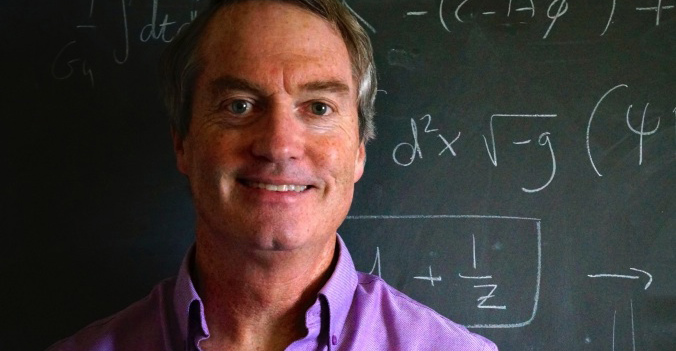
Joseph Polchinski Named 59th Annual Faculty Research Lecturer
When UC Santa Barbara physics professor Joseph Polchinski received an urgent voicemail from his colleague John Bowers, he wasn’t worried. The two are friends who ride bikes and play hockey together. But Bowers, UCSB’s 2013 Faculty Research Lecturer, was calling to tell Polchinski he’d been selected as the 2014 recipient. Faculty Research Lecturer is considered the highest honor bestowed by the university faculty on one of its members.
Polchinski will deliver his lecture in the fall.
“One reason this is such a great honor is that UCSB has played such a big role in my research,” said Polchinski, who is also a permanent member of the Kavli Institute for Theoretical Physics (KITP). “I really feel like my science blossomed when I came to UCSB and KITP. Having quality people to interact with, to exchange ideas with and offer different perspectives has had a huge impact on my work.”
Polchinski’s lecture, “Space-Time Versus the Quantum,” will cover the yin and yang of general relativity and quantum mechanics, how they are connected and the debate about their roles in understanding black holes. According to Polchinski, the theory of the Big Bang requires a deep understanding of how quantum mechanics — the branch of physics that deals with physical phenomena at microscopic scales — and gravity (i.e. relativity) connect. This is the focus of his most current research.
Black holes provide excellent ground for exploring these two principles. Forty years ago British physicist Stephen Hawking demonstrated that black holes in general relativity are featureless, or as American theoretical physicist John Archibald Wheeler said, “Black holes have no hair.” In quantum mechanics, black holes require an intricate atomic structure. But Hawking argued that black holes necessitate a modification of the laws of quantum mechanics.
Hawking’s view has been challenged by more recent work, largely that of Juan Maldacena of the Institute of Advanced Studies in Princeton, New Jersey. Maldacena argues that Hawking was wrong about the need to modify quantum mechanics. Rather, Maldacena is convinced that our understanding of space-time has to be modified, that the basic building blocks are not as we thought.
In the past couple of years, Polchinski has worked with students and fellow physicist Don Marolf to sort out his conundrum. “If Maldacena is right and Hawking is wrong and information is not lost, what does Hawking’s original argument say?” Polchinski asked. “We came to a conclusion that disturbed us, which is in conflict with Einstein’s theory. Hawking had quantum mechanics losing; Maldacena had space-time losing and now we don’t know what to think. Is there something in the middle? I’ll try to explain these issues in my talk.”
Best known for his discovery of D-branes — extended structures that appear to be central to the mathematics and physics of string theory — Polchinski is the author of a widely used two-volume text on string theory.
He received his Bachelor of Science degree in physics from the California Institute of Technology in 1975 and his Ph.D. in physics from UC Berkeley in 1980. After two-year stints as a research associate at the Stanford Linear Accelerator and at Harvard, Polchinski joined the faculty at the University of Texas at Austin in 1984. He moved to UC Santa Barbara in 1992.
“I just owe so much to UCSB for helping me realize my goals,” Polchinski added, “and that’s another reason why it’s so rewarding to give this lecture.”
Polchinski is the recipient of numerous honors and awards, including the 2013 and 2014 Physics Frontiers prizes, the American Physical Society’s Dannie Heineman Prize for Mathematical Physics and the International Center for Theoretical Physics’ Dirac Medal. He is a fellow of the American Physical Society and the American Association for the Advancement of Science and a member of the American Academy of Arts and Sciences and the National Academy of Sciences.



